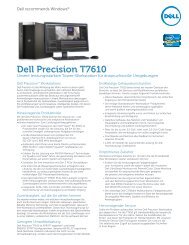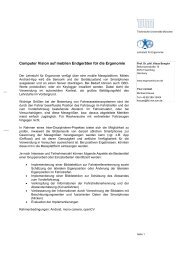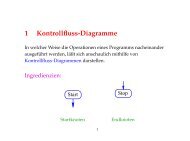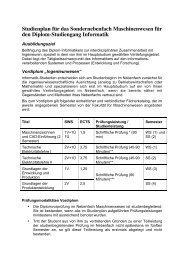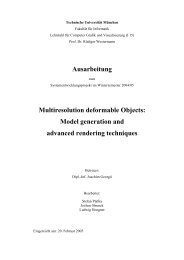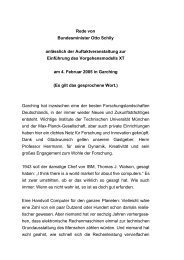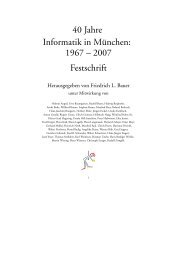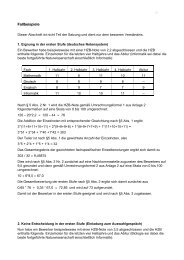A Generic and Scalable Pipeline for GPU Tetrahedral Grid ... - TUM
A Generic and Scalable Pipeline for GPU Tetrahedral Grid ... - TUM
A Generic and Scalable Pipeline for GPU Tetrahedral Grid ... - TUM
You also want an ePaper? Increase the reach of your titles
YUMPU automatically turns print PDFs into web optimized ePapers that Google loves.
at once if 8 bit scalar values are assumed. This implies that<br />
every spherical shell is as thick as to contain exactly 16 slices<br />
with regard to the current sampling step size. In account of<br />
this number, four additional texture render targets have to<br />
be used to keep intermediate sampling results. Without utilizing<br />
the multiple render target extension, still four samples<br />
can be processed at once.<br />
3.4 Blending Stage<br />
In the final stage up to four texture render targets are<br />
blended into the frame buffer. In each of its four components<br />
these textures contain the sampled scalar values on<br />
one spherical slice of the shell. The blending stage now per<strong>for</strong>ms<br />
the following two steps in front-to-back order. First,<br />
scalar values are mapped to color values via a user-defined<br />
transfer function. Second, a simple fragment program per<strong>for</strong>ms<br />
the blending of the color values via alpha-compositing<br />
<strong>and</strong> finally outputs the results to the frame buffer.<br />
4 Iso-Surface Rendering<br />
To avoid explicit construction of geometry on the <strong>GPU</strong>, perpixel<br />
iso-surface rendering can be integrated into our proposed<br />
rendering pipeline easily. Instead of sampling all the<br />
values along the view-rays only the intersection points between<br />
these rays <strong>and</strong> the iso-surface are determined on a<br />
per-fragment basis. Thereby, the primitive assembly <strong>and</strong> element<br />
construction stage remain unchanged, <strong>and</strong> only the<br />
fragment stage needs minor modifications.<br />
Given an iso-value siso, the view-ray passing through a fragment<br />
intersects the iso-surface at depth<br />
tiso = siso − �4 si · (beye)i<br />
i=0<br />
�4 si · (b)i<br />
i=0<br />
This <strong>for</strong>mula is derived from the condition that the scalar<br />
value along the ray (given in local barycentric coordinates)<br />
should equal the iso-value. It is worth noting that tiso is<br />
undefined if the denominator is zero. In this case the interpolated<br />
scalar values along the ray are constant, <strong>and</strong> we<br />
can either choose any valid value <strong>for</strong> tiso if the scalar value<br />
is equal to siso or the ray has no intersection with the isosurface.<br />
The computed barycentric coordinate b · tiso + beye of the<br />
intersection point is tested against the tetrahedron as described<br />
above. Only if the point is in the interior of the<br />
element an output fragment is generated. Otherwise the<br />
fragment is discarded.<br />
In this particular rendering mode the data representation<br />
stage has to be modified slightly. Instead of building an<br />
active element list <strong>for</strong> every shell, only one list that contains<br />
all elements being intersected by the iso-surface is built.<br />
These tetrahedra can then be rendered in one single pass, or<br />
in multiple passes if more elements are intersected by the<br />
surface than can be stored in a single texture map. The<br />
blending stage becomes obsolete <strong>and</strong> can be replaced by the<br />
st<strong>and</strong>ard depth test to keep the front-most fragments in the<br />
frame buffer. A fragments’ depth value is set to the depth<br />
of the intersection point in the fragment program. Finally,<br />
it should have become clear from the above description that<br />
per-element gradients can be computed in the primitive construction<br />
stage as well. Gradients are assigned as additional<br />
per-vertex attributes to the fragment stage <strong>for</strong> lighting calculations.<br />
5 Cell Projection<br />
<strong>Tetrahedral</strong> cell projection is among the fastest rendering<br />
techniques <strong>for</strong> unstructured grids as every element is only<br />
rendered ones. However, it requires a correct visibility ordering<br />
of the elements, <strong>and</strong> it can be time consuming to achieve<br />
such an ordering in general. To demonstrate tetrahedral cell<br />
projection we employ the tangential distance or power sort<br />
[8] on the CPU to determine an approximate ordering.<br />
<strong>Tetrahedral</strong> cell projection can be achieved by a slight modification<br />
of the fragment stage. Given the fragments’ depth<br />
zin, the barycentric coordinates of this fragment can be computed<br />
as<br />
bin = b/l · zin + beye. (2)<br />
The intersection with each of the faces of the corresponding<br />
tetrahedron can be calculated by using the ray equation<br />
bout = b/l · t + beye in barycentric coordinates. To compute<br />
bout, four c<strong>and</strong>idate parameters tl, l ∈ {0, 1,2, 3} are obtained<br />
by alternately setting the components of bout to zero.<br />
As the ray parameter t = zin corresponds to the entry point<br />
of the ray, the value of t at the exit points is determined by<br />
zexit = min{tl : tl > zin}.<br />
The barycentric coordinate of the exit point can then be<br />
derived according to equation (2).<br />
From the barycentric coordinates of the entry <strong>and</strong> exit point<br />
the length of the ray segment being inside the tetrahedron<br />
can be calculated. This in<strong>for</strong>mation is required to compute<br />
a correct attenuation value <strong>for</strong> every fragment [17]. The<br />
barycentric coordinates are used to obtain scalar values at<br />
the entry <strong>and</strong> exit point, which are then integrated along the<br />
ray.<br />
6 Implementation<br />
As current graphics hardware does not support geometry<br />
shaders to construct geometry on the <strong>GPU</strong>, the primitive<br />
assembly stage <strong>and</strong> the primitive construction stage are simulated<br />
via multiple rendering passes.<br />
Once the CPU has uploaded the index texture to the <strong>GPU</strong><br />
(see Section 2), a quad covering four times as many fragments<br />
as active elements is rendered. Every fragment reads<br />
the respective index <strong>and</strong> per<strong>for</strong>ms one dependent texture<br />
fetch to get the corresponding vertex coordinate. The 4th<br />
component of each vertex is used to store the element index.<br />
This index is used in the final fragment stage to fetch the<br />
barycentric trans<strong>for</strong>mation matrix. The vertex coordinates<br />
are written to a texture render target, which is either copied<br />
into a vertex array (on NVIDIA cards) or directly used as a<br />
vertex array (on ATI cards). In this pass, the trans<strong>for</strong>mation<br />
of vertices into eye coordinates can already be per<strong>for</strong>med.<br />
In a second pass, each active tetrahedron reads its four vertices<br />
as described <strong>and</strong> computes the last row of the barycentric<br />
trans<strong>for</strong>mation matrix, beye, which is stored in a RGBA



